#all the vermeers in new york
Text
All The Vermeers In New York rn

Johannes Vermeer's Other Girl With A Pearl Earring or whatever, staying put at The Met
In 1990 Jon Jost made a movie called All The Vermeers of New York, which at that point was—and most of the time is—eight. The Frick didn't lend their Vermeers once in a century, but right now they're renovating, so they lent all three. The Met has five, and may lend one here or there, but now has lent two. So NYC went from eight Vermeers to three.
Which is at least better than DC, which went from four Vermeers, until it lost one in a giant self-own, by changing the attribution, to three, but now it's at zero, because all of them went Amsterdam for the biggest Vermeer show ever, including the studio one, which the Dutch are like, still looks like a Vermeer to us, send it over!
https://greg.org/archive/2023/02/10/all-the-vermeers-in-new-york-rn.html
6 notes
·
View notes
Text
Weyauwega, Wisconsin
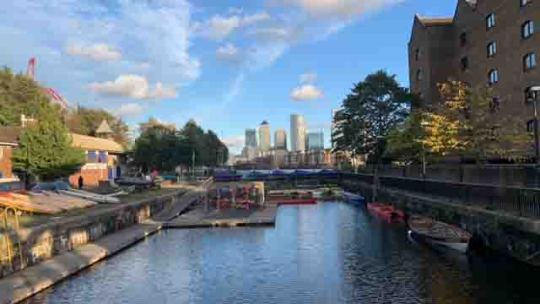
View On WordPress
#All the Vermeers in New York#Casa do Silencio#Clara Jost#Felicidade numa panela#Joanna Pocock#Marilyn Katz#Meine Liebe#Robina Rose#Santiago de Compostela#Surrender#The Mobilization 1968#Weyauwega#Wisconsin
1 note
·
View note
Text
Stress Relief Part One
Masterlist | Next Part
Pairing: Marcus Pike x Reader
Rating: Explicit - 18+ Only
Notes: The first few chapters aren't explicit, so I'll add the necessary labels when they're needed. Chapters are also going to be shorter just in general. I've been sitting on this one for a w h i l e.
Not beta-read
Warnings: Me pretending to know anything about art crime, art forgery, or the FBI, or Ptolemaic art. Don't get me wrong, I did some research but uhhh. Ya know.
Summary: Marcus Pike was an optimist by rights and a realist when necessary. You were a realist by rights, and only allowed yourself to be an optimist in your dreams—and hardly ever then.

Anyone would agree that Marcus Pike was, by and large, the kindest supervisor in the D.C. office. That didn’t mean that there were never any problems—within his task force, or the department. A genial nature didn’t guarantee a conflict-free environment. More often than not, you and Marcus locked horns.
It came down to how you each tended to handle your cases. Neither of you did it in a way that was wrong, but your styles were, on the surface, so incredibly different. Marcus liked to round into the work, to check and double-check with the victims and witnesses before moving on to the hard facts. You tended to go right to the paper trail, the art, the provenance, and forensics. As those things developed, you did the legwork, went over the soft details, followed up with the victims and witnesses.
Marcus Pike was the more senior agent, you were the more junior agent.
Marcus Pike liked early mornings. You preferred late nights.
Marcus Pike liked to believe that every case that crossed his desk could be resolved cleanly. You were rarely so certain.
Marcus Pike was an optimist by rights and a realist when necessary. You were a realist by rights, and only allowed yourself to be an optimist in your dreams—and hardly ever then.
So you were already sort of dreading getting assigned a case with the golden boy head of your task force. You’d been working it alone for the last few months. It was slow going, but that was no fault of your intel or your methods—it was just the nature of the case.
If you thought art thieves liked to sit on a stolen Rembrandt or a Vermeer—fuck, you had not been prepared for how long it takes to move a Ptolemaic relief of Cleopatra V. Either the sellers were holding it as collateral, had no idea what it was, or couldn’t move it.
The relief fragment had been in transport from the National Museum of Egyptian Civilization to the Metropolitan Museum of Art. It had landed in New York, placing it on American soil—but before it could leave the airport, it had been snatched. Six people—at least one male, though the rest were presumed to be as well—dressed entirely in black, brandishing guns. It was possible that they’d been planning on simply snatching the silver and emerald diadem that was meant to be shipped over as well, but it had been held back from being shipped with the relief.
The guards of the relief had all been witness to the heist. One had attempted to go after the robbers, but had been clubbed over the head with the butt of a rifle and knocked unconscious. Only one of the assailants had spoken—the one that had instructed the guards to back away from the crate containing the piece. The same man had ordered the guard to let go of the crate when he’d refused, and ordered one of his accomplices not to shoot.
Pike hadn’t even asked for your files first. He asked for the list of witnesses, victims, and suspects. You’d given it over willingly—hell, you’d had it ready. But you'd felt a little less willing when you saw interview invites flooding your mailbox. Pike invited you to join in person—he insisted on it. You understood, in a sense; you knew that, having interviewed them before, this would ease them into the idea of Marcus working on the case, and having you in the room to reassure them could shake loose the odd new detail. You knew why it was helpful. You just hated retracing your steps like this. You could be working on valuable leads in this time, but no—
--
You did have to admit that Pike was adept with witnesses. He was soft-voiced, gave easy smiles, offered people time and space to answer questions, giving encouraging nods and soothing little, "Great. That's great, that's so helpful,"s every now and again. He worked you into the conversation, referenced details that you had ‘mentioned’ to him, helped you coax additional details from the witnesses.
And you had to hand it to him—throughout the course of the conversation, he'd unearthed a couple of additional leads.
Whether or not you liked him, or his methods, Pike knew what he was doing.
Tag list: @missredherring ; @fantasticcopeaglepasta ; @paintballkid711 ; @massivecolorspygiant ; @blueeyesatnight; @recklessworry ; @amneris21 ; @ew-erin ; @youngkenobilove ; @carbonated-beverage ; @lorecraft ; @moonlightburned ; @milf-trinity ; @nolanell ; @millllenniawrites ; @chattychell ; @dihra-vesa ; @videogamesandpoorlifechoices ; @missswriter ; @thembosapphicclown ; @brandyllyn ; @wildmoonflower ; @buckybarneshairpullingkink ; @mad-girl-without-a-box ; @winchestershiresauce ; @writefightandflightclub ;
#Marcus Pike x Reader#Marcus Pike x You#Marcus Pike/Reader#Marcus Pike?You#Marcus Pike fic#Marcus Pike imagine#Stress Relief
110 notes
·
View notes
Text
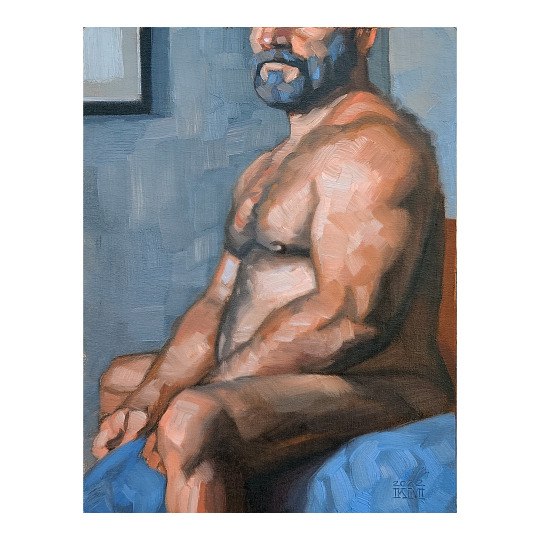
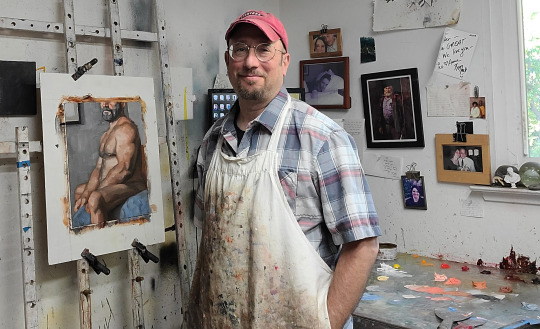

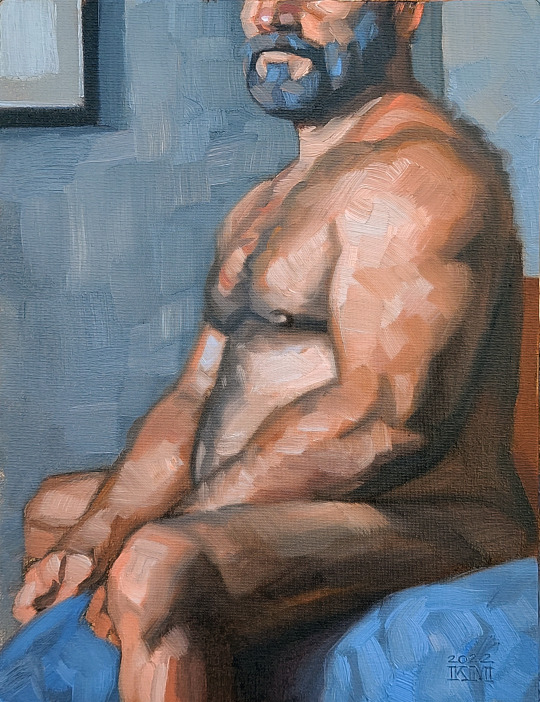
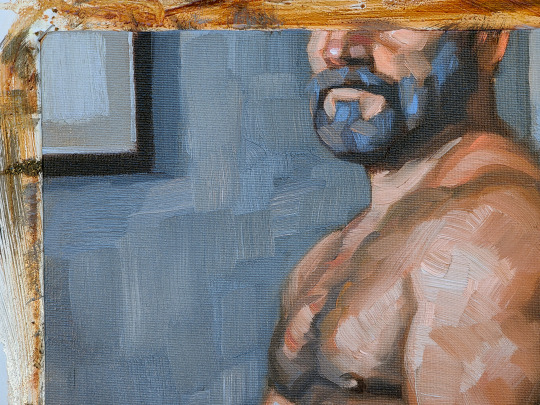



This painting is on Ebay for a one day auction. Bidding starts at $375 Auction ends 10/28/2022 https://www.ebay.com/itm/275517469059
Bear in Morning Light, 12x16 inches oil on canvas panel by Kenney Mencher
I was thinking about the light and color in Vermeer's paintings when I designed and painted this,
The subject matter of most of my paintings deals with thicker middle aged me often referred to as bears. I'm trying to represent the beauty of older hyper masculine men who often get overlooked by our more youth oriented culture.
In gay culture, in particular in the gay male subculture, gay bears, more commonly referred to as just a bear, is a larger - and often hairy - bisexual or gay man who is seen to portray or display a form of untamed, rugged, wild masculinity, often with a full beard, chest hair, and a lot of other body hair.
Generically speaking, the term bear is used to describe men who portray the aesthetics of working-class manhood. There is also a strong connotation between bears and the rural LGBT community.
Bear culture is often associated with discovering forms of masculinity, as gay men queer what it means to be masculine through the reputation of being kind, sensitive, and affectionate. As such, the bear subculture has made an important contribution to changing the public perception of the larger gay community, by showing that not all gay men have the same physical appearance - in particular regarding facial and body hair - and that there is no one way of being "mainstream gay." In doing so, the bear movement has also not only contributed to bear identity and gay male culture but to the masculine gender role in general.
One of my favorite things to do is to paint small brushy portraits of faces. It's one of the things that I learned to do in high school, I went to the High School Art Design in New York City, where I studied painting with Max Ginsburg and Irwin Greenberg. Greenberg conducted an extra open studio time before school began that he called "The Old Hat Painting Club." We would get to school about two or three hours early and one of us would model for the rest of the students who would begin painting a wet into wet or "ala prima" painting of either the full figure, head and shoulders, or just the face of a single person. We would all dig into our pockets and contribute a quarter or $.50 to pay the model. This was way back in 1979 so that actually could amount to going out for sandwich or a meal.
Greenberg taught us a quick 19th-century style that is often referred to as wet into wet or sometimes ala prima. What this means is we with telling the canvas with some turpentine and a little bit of burnt sienna paint and then start drawing into this soupy mix with the darker brown, usually burnt umber, and draw with the brush. We would immediately start to model the shading or value structure as we painted and we would sometimes wipe out the lighter areas to be able to see the value structure or structure of light and shadow as it moved across the figure or face. You have to work very quickly and sometimes you only had two or three two-hour sessions to complete the painting and our teachers were so skillful that they were able to make a completed portrait, in the style of John Singer Sargent, sometimes in as little as an hour. It was a kind of magic and we strove to learn how to do that. Now at the ripe old age of 57 I'm able to paint beautiful young people and sometimes older handsome men in anywhere between 2 to 5 hours. In the style of my teachers. This painting took about, 6 to 7 hours, I'm not as good as Greenberg.
55 notes
·
View notes
Text
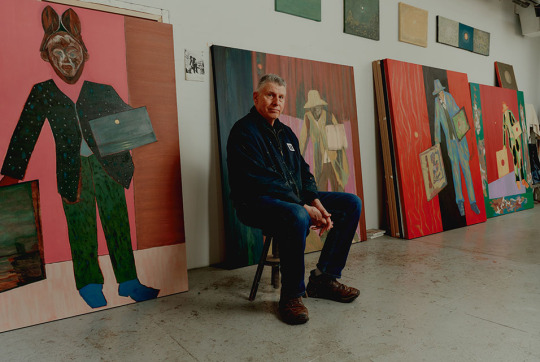
Making Art by Day, Guarding It by Night.
Greg Kwiatek, a painter, at his studio in the garment district in Manhattan, April 21, 2023. Over 25 years walking the museum’s midnight shift, Kwiatek learned how to look for the hidden subtleties of paintings, which helped inform his own. (Victor Llorente/The New York Times)
NEW YORK, NY.- The small hours of the morning — when the galleries were empty, hushed and dim — were Greg Kwiatek’s favorite part of his 25 years as a night guard at the Metropolitan Museum of Art, when he could spend hours looking at a single painting like El Greco’s “Christ Carrying the Cross,” J.M.W. Turner’s “Whalers” or Johannes Vermeer’s “A Maid Asleep.”
Then, shortly after sunrise, Kwiatek, now 74, went home to his rent-controlled railroad flat apartment in Hoboken, New Jersey ($557 a month) to work on his own paintings, which were often inspired by those he’d guarded at the museum.
Now Kwiatek’s work is on view, through May 14, in a small group show at Fierman Gallery on the Lower East Side.
“He developed a very intimate relationship with much of the collection, and a lot of that has really permeated his practice,” said Alissa Friedman, who organized the show, “Everybody Knows This Is Nowhere,” which includes work by artists Chonon Bensho and Amy Bessone. “Some of his works are direct homages.”
Working at the Met taught Kwiatek how to look. When the Met had a Francis Bacon retrospective in 2009, for example, Kwiatek said he logged about 70 hours.
“You get an hour to do a route,” Kwiatek said in a recent interview at his cramped garment district studio, referring to one of the museum’s seven sections. “I would do a route in maybe 40 minutes, and then I would have 20 minutes to focus on one piece. I got to know some paintings pretty well by doing that.”
Kwiatek is emblematic of a large but little-known swath of the art world — those who have never been famous and likely never will be but doggedly, passionately keep at it anyway.
His paintings are quiet and understated. He often makes versions of the same image repeatedly — in particular a series inspired by a 1906 photograph of Paul Cézanne carrying his paintings. The small ones go for about $5,000; the larger ones for about $20,000. He also painstakingly sews needlepoint images, many of which echo his paintings of the moon and sun.
A tall, solid man from a Polish family in Pittsburgh, Kwiatek radiates the taciturn intensity of an introvert who would much rather be communing with paintings than humans.
Indeed, this is what made Kwiatek gravitate toward the overnight shift at the Met in 1987, where he worked until retirement in 2011. “I’m not a people person,” Kwiatek said. “I figured by working at night, I wouldn’t have to deal with the public much.”
The schedule wasn’t easy — working from 12:15 a.m. to 8:20 a.m. and then going home to paint meant he was always tired. But the lifestyle suited him. And he took pride in the work.
“My job was to walk at least four hours a night,” Kwiatek said. “You know every square inch of this building — you’re doing surveillance. You cover every gallery, every catwalk, every roof, cellar, offices, bathroom. You’re looking for fire and water and so on.”
It’s been over a decade since Kwiatek last walked these routes, yet the Met’s physical plant remains in his bones. “Route Three includes European painting, painting conservation, Japanese art, musical instruments, Arms and Armor,” he said. “The Rockefeller wing, that would be Route Six. You’re looking at all the cases. You’re looking at that boat that’s hanging from the ceiling.
“We’re drinking 20 cups of coffee a day. I would sleep an hour on my lunch break at 4 o’clock in the morning,” he continued. “You’re living with works of genius. And I’m not a genius. But I knew that what I had the privilege of guarding — it was otherworldly.”
Kwiatek was featured in Alexandra M. Isles’ 2011 documentary “Hidden Treasures: Stories from a Great Museum” talking about the layers in El Greco’s “View of Toledo.”
“From this point of view, this modest-size painting looks like a very large painting, the details are not clear — is it a landscape? Is it an abstraction? Maybe it’s a mirage,“ Kwiatek says in the film. “The hidden subtleties will not reveal themselves unless one is willing to come back time and time again and live with this work in an extended relationship.”
Growing up near Polish Hill in Pittsburgh — where his father worked in the steel mill, and his mother crocheted in front of soap operas — Kwiatek got his first exposure to art at the historic Immaculate Heart of Mary Church, which was influenced by baroque and Renaissance architecture.
Art Daily
14 notes
·
View notes
Text

Working on...something else. 🤷♀️
Adam had been to the Gardner before.
His first vacation after joining Art Crimes, he'd taken the train to New York City, then Boston. The trio was meant to be educational; in his new unit, he was the only one without an art-related degree. He hadn't even taken a single art class in college. But he tried to catch up. He spent nights and weekends in the plethora of museums in DC. When he'd been sent to Chicago to work a theft from a private collection, he stayed an extra day so he could visit the Art Institute. So when Helen all but mandated Adam use vacation days to get away from work, the easiest option—other than staying in his apartment in Foggy Bottom—had been to take a work-adjacent vacation. He started in New York—at the Met, then MoMA, then the Guggenheim, then the Cloisters—before he finished up in Boston. First the MFA.
Then the Gardner.
By that point, he'd lost track of how many times he'd read the file on the Gardner heist. How many times he'd looked at the photos of the empty gilt frames in the Dutch Room. Seeing them in person was something else though. Photos never got the shade of the room's green brocade wallpaper quite right, nor did they get the right saturation of the light filtering through the shaded windows next to where the stolen Vermeer and Flinck had been displayed back-to-back.
Adam spent a very long time in the Dutch Room on that trip.
He spent even more time in the Dutch Room the morning after he met with Ronan Lynch.
6 notes
·
View notes
Text

2024 archive of books/films seen
★ = loved ⭑ = liked ⋆ = didn’t care for
Books
★ Independent People (Haldór Laxness) 1934
Films
★ Come and See (d. Elim Klimov) 1985
⭑ Late Spring (d. Yasujiro Ozu) 1949
⋆ All the Vermeers in New York (d. John Jost) 1990
⋆ Porco Rosso (d. Hayao Miyizaki) 1992
⭑ The Passion of the Christ (d. Mel Gibson) 2004
Shows
★ The Chosen (d. Dallas Jenkins) 2018-

2 notes
·
View notes
Text
Big Galleries Around the World Are Hosting Major Exhibitions

Some of the biggest galleries in the world are hosting major exhibitions this week, featuring works by some of the most famous artists in history. From Jeff Koons's Apollo sculptures in New York City to Yayoi Kusama's mirrored rooms in Los Angeles, there's something for everyone.
These are just a few of the many great exhibitions that are happening at the biggest galleries in the world this week. If you're looking for a cultural experience, be sure to check them out!
Jeff Koons: Apollo at the DESTE Foundation Project Space in Hydra, Greece.
This exhibition features four new sculptures by the iconic American artist, all inspired by the Greek god Apollo. The sculptures are made from materials such as stainless steel, mirror-polished bronze, and polished marble. They are all large-scale and highly reflective, and they create a dazzling visual effect. The exhibition is on view from June 24 to September 17, 2023.
Yayoi Kusama: Infinity Mirrors at the Museum of Fine Arts, Houston.
This popular exhibition features a series of mirrored rooms filled with Kusama's signature polka dots and infinity patterns. Visitors can step into the rooms and experience the optical illusions created by the mirrors and the patterns. The exhibition is on view from June 25 to September 10, 2023.
Picasso and the Allure of Africa at the Museum of Modern Art, New York City.
This exhibition explores Picasso's lifelong fascination with African art and its influence on his work. It features over 200 works of art, including paintings, sculptures, and drawings. The exhibition is on view from June 28 to October 9, 2023.
Van Gogh: The Immersive Experience at the Lighthouse Artspace in Miami.
Van Gogh: The Immersive Experience
This digital art exhibition allows visitors to step inside Van Gogh's paintings and experience his work in a whole new way. The exhibition uses projection mapping technology to create a 360-degree experience of Van Gogh's paintings. Visitors can walk through the paintings and feel like they are surrounded by them. The exhibition is on view from June 23 to September 10, 2023.
Johannes Vermeer: The Late Works at the National Gallery of Art, Washington, D.C.
This exhibition features a selection of Vermeer's most famous paintings from his later years, including "The Girl with the Pearl Earring" and "The Milkmaid." The paintings are all on loan from museums and private collections around the world. The exhibition is on view from June 23 to September 10, 2023.
Read the full article
3 notes
·
View notes
Photo

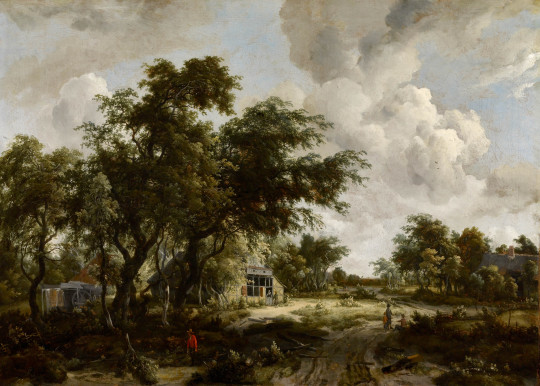
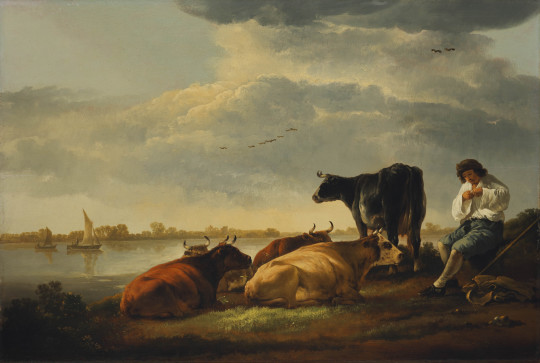
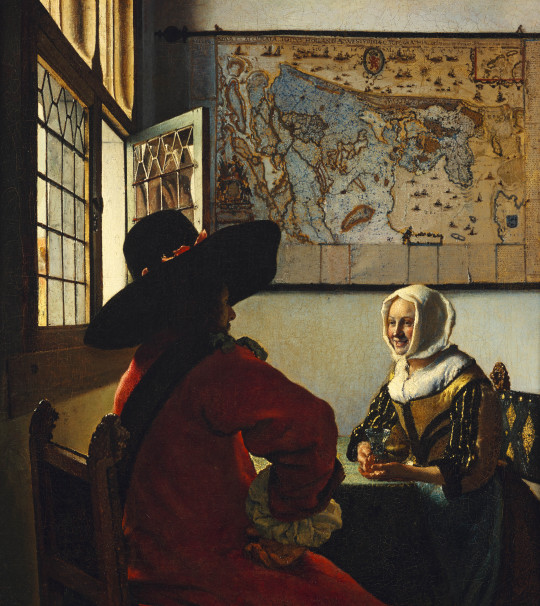

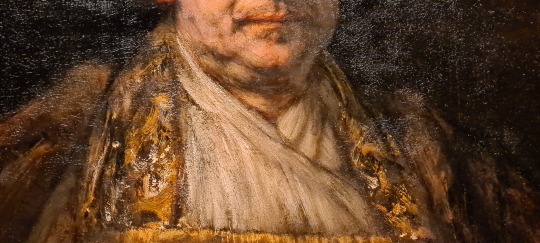
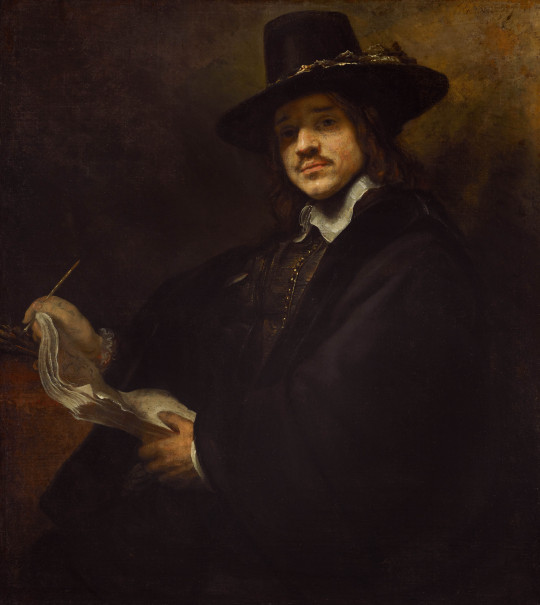



Wat? Landschap met een voetbrug door Jacob van Ruisdael (1652), Landschap met watermolen van Meindert Hobbema (ca. 1665), Rivierlandschap met herder en koeien door Aelbert Cuyp (Ca. 1650-1660), Soldaat en lachende vrouw door Johannes Vermeer (ca. 1657), Zelfportret (1658) (met detail) en Portret van een jonge kunstenaar (ca. 1650-1660) door Rembrandt van Rijn en Portret van een man (met details) door Frans Hals (ca. 1660)
Waar? Tentoonstelling Manhattan Masters – Hollandse schilderijen uit The Frick Collection in het Mauritshuis, ’s-Gravenhage
Wanneer? 24 november 2022
Aan de rand van Central Park in New York staat de villa waarin The Frick Collection is gevestigd. Het museum huisvest de verzameling van ondernemer en kunstverzamelaar Henry Clay Frick met wat daar later aan is toegevoegd. Nu dit museum wordt gerenoveerd, leent het tien topstukken van Nederlandse meesters uit aan het Mauritshuis in Den Haag.
Een tentoonstelling van slechts tien werken klinkt niet veelbelovend, maar kwantiteit is niet alles en in dit geval geldt het Bauhaus-motto ‘Less is more’ meer dan ooit. De kwaliteit van de tentoongestelde werken is fantastisch en het is heerlijk om je aandacht slechts over een beperkt aantal doeken te hoeven verdelen.
Jacob van Ruisdael is natuurlijk vooral beroemd vanwege zijn luchten. Nu moet ik bekennen dat ik van de meeste werken van deze schilder een beetje somber wordt. Maar niet van het werk dat hier hangt: Landschap met een voetbrug. Het werk vertoont veel diepte en de kleuren zijn zo intens alsof het werk gisteren is geschilderd. Het werk is ongetwijfeld recent gerestaureerd of ten minste schoongemaakt. We zien een heuvelachtig landschap. Links zit een heer te paard, terwijl een tweede paard door een knecht bij het leidsel wordt vastgehouden. De berijder van dit tweede dier is afgestapt en sluipt met het geweer in de aanslag de helling op naar de loopbrug. Zijn doelwit is waarschijnlijk het paar eenden dat op de rivier dobbert. Aan het water zit een hengelaar. Hij heeft zijn hoofd gedraaid naar de paarden. Werd hij bij het hengelen gestoord of is het nieuwsgierigheid die zijn aandacht afleidt van waar hij mee bezig is? In de verte op een heuvel zien we een kerk en een molen, wat erop duidt dat zich daar een dorp bevindt. Natuurlijk is de wolkenlucht fraai geschilderd, zoals je van Ruisdael mag verwachten, maar dat geldt zeker ook voor de bomen. Vooral de oude boom links, die zijn wortels in de, zo te zien rotsachtige, bodem heeft begraven is geweldig weergegeven. Het licht speelt door het gebladerte en zorgt voor een prachtige gloed. Als ik na de tentoonstelling thuis de catalogus opensla, zie ik op de reproductie weinig terug van wat dit doek in realiteit zo onweerstaanbaar maakt. Dat toont maar weer eens aan dat niets op kan tegen ‘het echte werk’.
Een ander landschap is van de hand van Ruisdaels leerling Meindert Hobbema, een schilder die ik beter ken van de Amsterdamse kade dan van zijn schilderijen. Ook dit werk is van een verbluffende kwaliteit. Net als het schilderij van Ruisdael lijkt het zo uit het restauratieatelier afkomstig. Het shirt van de man links vooraan is helderrood en ook het geel van het huisje is sprankelend. Aan de deur van het huisje is een man, leunend op een stok, in gesprek met iemand die binnen staat. Is de man buiten een bedelaar? Dat lijkt zeker het geval te zijn bij de man die rechts van het pad zit. Hij strekt zijn hand uit naar een man en een jongen die tegenover hem staan. Net als bij het landschap van Ruisdael zijn de bomen ook in dit schilderij heel mooi weergegeven.
Van Aelbert Cuyp zien we een rivierlandschap. Een herder frummelt wat aan zijn hemd, terwijl vier van zijn koeien rustig aan de oever van een rivier liggen. Een vijfde koe staat en lijkt te kijken naar de zeilboten op het water. Zowel het tafereel als het gouden licht zijn typerend voor de Dordtse schilder. Een half jaar geleden bezocht ik de tentoonstelling In het licht van Cuyp in het Dordrechts museum. Deze expositie ging uitgebreid in op het werk van deze schilder en de invloed die hij had op andere, met name Engelse, kunstenaars.
Het eerste dat mijn aandacht trekt op Johannes Vermeers Soldaat en lachende vrouw is de landkaart van Nederland. Naar onze begrippen hangt de kaart op zijn kant, het westen naar boven. Ik zie dat mijn geboorte-eiland Walcheren hier nog echt een eiland is. Een ander interessant detail is het glas-in-loodraam. Dit zorgt voor een warme gloed, met name op het gezicht en de hoofddoek van de vrouw. Dit werk is een goede smaakmaker voor de grote Vermeer-tentoonstelling die volgend jaar in het Rijksmuseum zal plaatsvinden. In 1996 bezocht ik hier in het Mauritshuis de laatste grote Vermeer-expositie. Een ware blockbuster!
Het absolute pièce de résistance van deze tentoonstelling is het zelfportret van Rembrandt uit 1658. Tijdens zijn leven schilderde de kunstenaar zo’n tachtig zelfportretten, waarvan dit het grootste is. Rembrandt vereeuwigde zichzelf levensgroot in zestiende-eeuwse kledij, zittend in een leunstoel. De verfstreken zijn gedurfd, hier en daar haast wild, op het doek gezet. Kijk naar de band van de paltrok om Rembrandts nek! Maar het meest indrukwekkend aan dit portret is het doorleefde gezicht met de ogen die mij als beschouwer strak aankijken. Rembrandt voelt in dit schilderij niet als een kunstenaar uit een ver verleden, maar veeleer als een oudere vriend of een wijze oom.
Aan de wand links van dit magistrale werk hangt een werk van een navolger van Rembrandt. Wat een tegenstelling tussen de twee schilderijen! Hier zien we een jonge kunstenaar vol zelfvertrouwen. Zijn blik is zelfverzekerd. Het leven ligt nog grotendeels voor hem. Rembrandt heeft net een faillissement achter de rug, waarbij hij zijn huis (nu het Rembrandthuis) moest verkopen. Het leven heeft zijn sporen nagelaten in het gelaat van de kunstenaar.
Schreef ik dat Rembrandts verfstreken wild waren? Kijk dan ook eens naar het Portret van een man van Frans Hals. Hier is haast sprake van impressionisme avant la lettre. Het witte hemd is met woeste streken neergezet en de handschoenen, die de man in zijn hand houdt, zijn feitelijk niet meer dan een paar vegen verf.
9 notes
·
View notes
Text
2023
This year I visited 178 exhibitions, here is my top ten.

Vermeer, Rijksmuseum, Amsterdam
Perhaps not just an exhibition of the year, but one of a lifetime. Astonishing perfection in every brush stroke; words and reproductions do not capture the empathy contained in every painting that survives by Vermeer. Most of which were brought together at the Rijksmuseum for a truly exceptional exhibition. Unlike so many blockbusters of this type, the paintings did not feel (well ok too crushingly) crowded or overwhelmed by the throngs. Each was given space and a carefully considered semi-circular barrier so visitors could fan out from it. There was little in the way of text panels, no need to contextualise with artworks by other artists; the paintings were each given lots of space in sensitively and richly painted and floor-to-ceiling curtains. They were allowed a dignified space in order to sing to us. I contracted Covid-19 from the trip to Amsterdam which developed into Long-Covid; this left me changed fundamentally as a human as I battle(d) fatigue for months on end. I am still not sure if the impact on my health was worth the trip, but as I write these words I know it was. I will always remember the opportunity to see 28 of the 37 Vermeer’s all in one place at one time.

2. Philip Guston, Tate Modern, London
I want to lick and consume Guston’s paintings metaphorically and perhaps even literally, they ingest the eyeballs and linger in the mouth. Seeing the paintings together made so much sense, perhaps the curation sold the narrative but the exhibition made me think that the foray into full-on abstract expressionism was actually the inconsistency; right from the earliest paintings there was story-telling, narrative, figuration, politics, turmoil and a desire to point out what needs to change societally. With the pure abstract works, ambiguity felt too strong, everywhere else the balance was perfect, enough to be led and enough to form your own thoughts. So many works of greatness all together, the final room of grief was as heart-breaking and poetic as it comes.
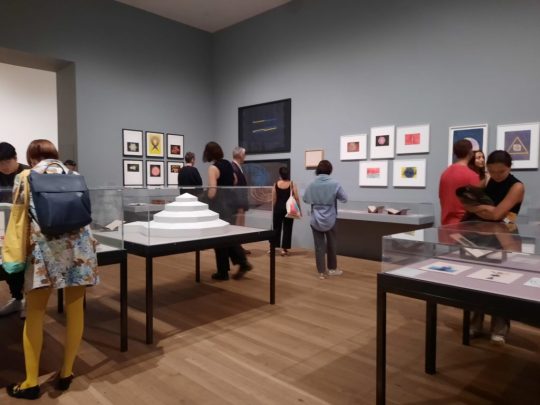
3. Hilma af Klint and Piet Mondrian, Tate Modern, London
This was an exhibition I had to see. I spent weeks preparing for the trip to go and see it. Having Long-Covid meant that I had to conserve and use my energy intensely - when everything saps strength and leaves you exhausted, from having a shower, to walking up stairs to reading a page of a book, then you have to be careful. T0 go to London for the day to see this exhibition was something I trained and equipped myself for/. I was so glad I did. The exhibition made me feel happy and lightness...an injection of art through the eyes which is so good for the soul. af Klint was paired with Mondrian, which made unexpected sense (to me, I know not to others) with so many surprising overlaps such as in their botanical paintings,and more general link to natural forms, the link to Theosophical thought and of course abstraction. One of my favourite rooms in the exhibition was titled the ether and was filled with sketchbooks, books, works by other artists and this amazing model of Mondrian's New York studio.

4. Mike Nelson, Hayward Gallery, London
A proper art-as-experience encounter, the atmosphere of being within each of the installations by Nelson, restated at the Hayward was palpable; senses, memories, possibilities spiralled outwards, creating new stories and narratives. An embodied and tacit experience of speculative and to be-found-out-and-created knowledge. A novel or series of novellas contained in a material-led happenstance. This felt like the sort of show a big institution is made for, enabling a coming together of elements that would not be possible in the world without the structure behind it.
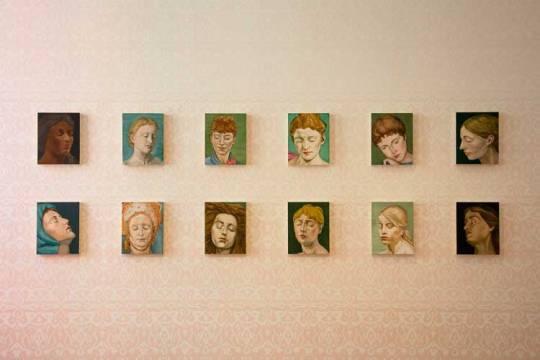
5. Rebecca Fortnum, Henry Moore Institute, Leeds
In many ways the opposite of the behemoth of the shows of the year above; this was a quiet and intimate exhibition of new drawings, paintings and hand-printed wallpaper by Fortnum. The paintings are transcriptions of sculptures by fifteen women who visited or worked at Auguste’s Rodin’s studio. An intention of the work is to offer insight and exposure to these often-overlooked female sculptors. Rodin is known to have trained women to sculpt in the late nineteenth century when they were not allowed to enter into art schools in France, and employed some of them as studio assistants (or the ‘praticienne’ of the show’s title). Many of the women artists that Fortnum has selected to make work from had in what the text panel calls “an extraordinary, and in many cases unpublished, life narrative.” The show also featured drawings of men that were sculpted by the women artists, creating a gendered distinction between female subjects in paint and male subjects in drawings, albeit that the subject of Fortnum’s work is actually the unpictured female artists.
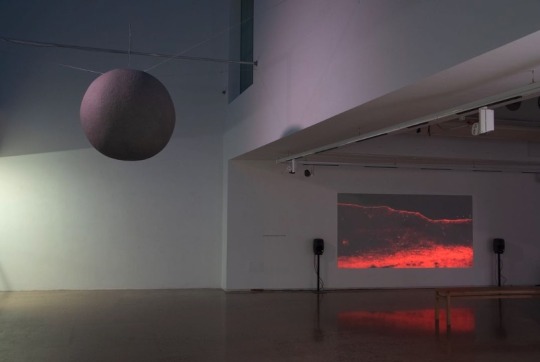
6. Oliver Ventress, Project Space Plus, Lincoln
A beautifully installed coming together of sculpture, sound and video by Ventress that all speculates on what is out there, what might be out there in a delicate oscillation between despair and hope of what our present and future might be. The work beckoned me in quietly, gently insisting that I spend time with it, to slow down by heartbeat to become in line with the tide in one sculpture or the sound emanating from a large grey spherical sculpture (apparently at 210.42hz the theoretical frequency of the moon. With the tuning in to the resonance of the work, came an opportunity to speculate on the future in the present from a position of calm, not panic, all too rare an opportunity in 2023.

7. Chad McCail, Turntable Gallery and tt88
You gotta love a bit of bonkers; a serpentine urban and rural landscape sweeps the carpet tiles on the high street, giants roam the gallery constructed from discarded detritus of the capitalist waste-culture, brains exude from trees and gonzo lizards pelt churches with walnut-like objects. Poke a bit further though and melancholy descends as the worst aspects of humanity seep everywhere: capitalist-greed, paedophilia, and environmental-apocalypse.

8. Brendan Lyons, Bridewell, Liverpool
A joyful form of institutional critique of painting, one rich in materiality. In one gallery several paintings line the walls, completely conventional in description. In one gallery a range of fixings for hanging paintings line the walls, completely conventional in description. That the description is for one and the same gallery is the magic of Lyons work. Each fixing has been constructed fully from paint, being both itself and a simulacra of the hidden elements of painting, an opening up and unlocking. In the other gallery three new pieces are bold in the way the first gallery is subtle. Ivy creeps down the walls and over canvas; parcel tape tries to fix a smashed glass of an empty frame; multiple blank canvas are tapped to the wall with Gaffa and parcel tape…or look a bit closer.
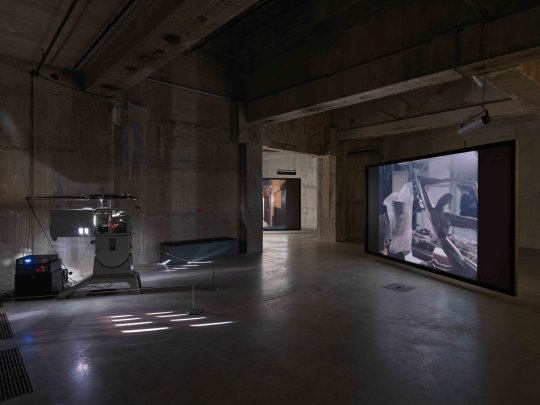
9. Rosa Barba, Tate Modern, London
The Tanks at Tate Modern are a brilliant space to encounter Barba’s work; the atmosphere of the space evokes the type of places the artist is attracted too, places that are pregnant with a past. 3 35mm film installations affectingly occupy the space, the visuals draw you in, the sound quivers with the image, but perhaps most evocatively the projectors percolate all the space in their industriousness that comes close to humanity in their presence.
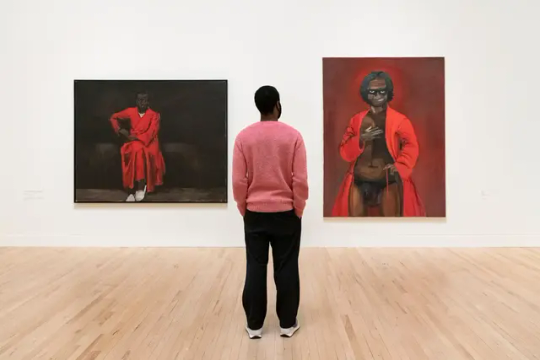
10. Lynette Yiadom Boakye, Tate Britain, London
I could have had several number tens on this list, significantly I whittled a shortlist down to five, all of which were painting exhibitions. So why does Yiadim Boayake become number ten? Perhaps it is the way she handles paint, something I wish I could inhabit? Or perhaps it is the way she creates stories with paints? Or perhaps it is the way she conjures personal lives, and memories of histories in the people she paints from imagination? Perhaps it is the way she invents archetypes for our time in the presence of the people? Or perhaps it is because I want to look, to spend time, to look harder, nearer, closer, more attentively? Or perhaps it is because I struggle with the words, the paintings do what (my) words can’t, reach the soul.
In 2023 I visited the following exhibitions:
30 December, Pesellino, National Gallery, London
30 December, Discover Liotard and the Lavergne Family Breakfast, National Gallery, London
15 December, Corrupt Vision, General Practice, Lincoln
15 December, Sam Scorer, Usher Gallery, Lincoln
30 November, 8 Acts of Love, Project Space Plus, Lincoln
24 November, Made in Scunthorpe, Fountain Arts, Scunthorpe
24 November, Glow Up , 2021, Scunthorpe
24 November, Swords into Ploughshares: Knives into Jewels, 2021, Scunthorpe
17 November, Daniel Richter, Thaddaeus Ropac, London
17 November, Endless Variations, Ordovas, London
7 November, Avery Singer, Hauser & Wirth, London
7 November, Christina Quarles, Pilar CorriasLondon
7 November, It All Starts With a Thread, Whitechapel Gallery, London
7 November, Anna Mendelssohn, Whitechapel Gallery, London
7 November, Johanna Billing, Whitechapel Gallery, London
7 November, Nicole Eisenmann, Whitechapel Gallery, London
7 November, In the Studio, Tate Modern, London
7 November, El Anatsui, Tate Modern, London
7 November, Phillip Guston, Tate Modern, London
7 November, Joan Mitchell, Tate Modern, London
14 November, Tread Softly, Gloam, Sheffield
14 November, Paul Housely, Persistence Works, Sheffield
14 November, Autumn Almanac III, Persistence Works, Sheffield
13 November, Nature Positive, Project Space Plus, Lincoln
27 October, Tim Murray-Browne, St. Marks, Lincoln
27 October, Maria Mavropoulou, St. Mary Le Whigford, Lincoln
27 October, Beccy McCray Engine Shed, Lincoln
27 October, Filthy Luker, Lincoln
27 October, Camille Baker, The Drill, Lincoln
27 October, Lumo Workshop and The Network, Lincoln
27 October, Dangerous Times, Lincoln
27 October, Lauren Hubbard, Waterstones, Lincoln
27 October, Touch & Glow, St. Marks,Lincoln
27 October, Marc Renshaw, Wealth Streams Development Agency, Gainsborough
24 October, John Dowling, Link Corridor, Lincoln
24 October, Birth and Design 23, Project Space Plus, Lincoln
21 October, Creativity Unlocked, Salthouse, Lincoln
21 October, Sam Tahmassebi and Harrison Taylor, Cornhill, Lincoln
21 October, Soft Egg, Don't Wear It, Salthouse, Lincoln
21 October, Unweeded, General Practice, Lincoln
21 October, Tyler Barker, Zara Sands, Walking Together, The Collection, Lincoln
21 October, Past and Present Practice, St Mary Le Whigford, Lincoln
21 October, SLQS - Straight from the Horses Mouth, St Mary Le Whigford, Lincoln
21 October, In My Perfect State, Cornhill, Lincoln
20th October, Artists in the Now, The Link Up, Limcoln
19 October, Obscene Pomegranate, Salt House, Lincoln
19 October, Gurminder Sikand, Trace, Nottingham
14 October, Nahem Shoa, Walker Art Gallery, Liverpool
14 October, John Moores Painting Prize, Walker Art Gallery, Liverpool
14 October, Tom Wood, Walker Art Gallery, Liverpool
14 October, Tim Spooner, Bluecoat, Liverpool
14 October, Brendan Lyons, Bridewell, Liverpool
14 October, About Face, 50_MV, Liverpool
14 October, Anthony Gormley, Crosby beach, , Liverpool
6th October, Grayson Perry, Lincoln Museum
6th October, Oliver Ventress, Project Space Plus, Lincoln
28 September, Ridykeulous (Nicole Eisenman & A.L. Steiner, with Sam Roeck): Ridykes’ Cavern of Fine Inverted Wines and Deviant Videos, Nottingham Contemporary
28 September, Green Unseen, Dajongly Gallery, Nottingham
28 September, Reimagining the Victorians, Dajongly Gallery, Nottingham
28, Community Choice, Usher Gallery, Lincoln
21 September, Method Lab 3, Trace Gallery, Nottingham
21 September, John Becka nd Matthew Cornford, Bonnington Gallery, Nottingham
21 September, Art (School) Histories, Bonnington Gallery, Nottingham
16 September, Chad McCail, Turntable Gallery
16 September, Chad McCail, Turntable 88 Gallery
10 September, Mark Judson, the hub, Sleaford
10 September, Together we are Powerful, the hub, Sleaford
10 September,Adaesi Ukairo, the hub, Sleaford
9, September, George Boole School, Lincoln Museum
9, September, CODED: Digital Art that Defies Definition, Lincoln Museum
8 September, MA Fine Art, University of Northampton
1 September, The Power of Printed Matter, Beam, Nottingham
27 August, A Sense of Place, Willoughby Memorial Gallery, Corbey Glenn
25 August, Bare, Project Space Plus, Lincoln
24 August, Strange Friends, Hauser and Wirth, London
24 August, Connect, Reveal, Conceal, Hauser and Wirth, London
24 August, Holding Space, Hauser and Wirth, London
24 August, To Bend the Ear of the Outer World: Conversations on contemporary abstract painting, Gagosian, London
24 August, Glenn Brown, The Brown Collection, London
24 August, The Belly and the Guts, Alice Amati, London
24 August, Tomas Saraceno, Serpentine Gallery, London
24 August, Lina Ghotmeh, Serpentine Gallery, London
24 August, Gabriel Massan, Serpentine Gallery, London
24 August, Atta Kwami, Serpentine Gallery, London
24 August, Matthew Collings, Wellington Arch, London
24 August, Summer Show, Skarstedt, London
24 August, Malediction and Prayer, Modern Art, London
24 August, Moki Cherry, ICA, London
24 August, Samson Kambalu, London
24 August, Nira Pereg, Tate Modern, London
24 August, Vivian Sundaram, Tate Modern, London
24 August, Jannis Kounellis, Tate Modern, London
24 August, Rosa Barba, Tate Modern, London
24 August, Rasheed Araeen, Tate Modern, London
24 August, Art and Text, Tate Modern, London
24 August, Lawrence Weiner, Tate Modern, London
24 August, Hilma af Klint and Piet Mondrian, Tate Modern, London
10th August, Erwin Wurm, Yorkshire Sculpture Park
10th August, Lindsey Mendrick, Yorkshire Sculpture Park
10th August, Leonardo Drew, Yorkshire Sculpture Park
10th August, Catriona Robertson, Art House, Wakefield
10th August, The Royal Society of Sculptors presents: The Gilbert Bayes Award, Art House, Wakefield
10th August, Tony Wade, Art House, Wakefield
10th August, The Art of the Potter: Ceramics and Sculpture from 1930 to Now, Hepworth, Wakefield
10th August, If Not Now, When? Generations of Women in Sculpture in Britain, 1960 – 2022, Hepworth, Wakefield
10th August, Hurvin Anderson Curates, Hepworth, Wakefield
10th August, Hurvin Anderson, Hepworth, Wakefield
25, July, Kresiah Mukwazhi: Kirawa, Nottingham Contemporary
25, July, Abbas Zahedi: Holding a Heart in Artifice, Nottingham Contemporary
25, July, Eva Koťátková: How many giraffes are in the air we breathe? , Nottingham Contemporary
25, July, Jade Foster, TG, Nottingham
25, July, Line Nielsen, Beam, Nottingham
25, July, Residents & Members | Video Materials, Primary, Nottingham
25, July, Sam Keogh, Primary, Nottingham
21 July, The Weight of Words, Henry Moore Institute, Leeds
21 July, Egon Altdorf, Henry Moore Institute, Leeds
21 July, Things Left Unsaid: Percy Wyndham Lewis, Iris Barry, Helen Saunders and the story of Praxitella, Leeds Art Gallery
7th July, Patrick Hartigan, Moon Grove, Manchester
7th July, Office of Arte Útil, Whitworth Art Gallery, Manchester
7th July, Standardisation and Deviation The Whitworth Story, Whitworth Art Gallery, Manchester
7th July, (Un)defining Queer, Whitworth Art Gallery, Manchester
7th July, Traces of Displacement, Whitworth Art Gallery, Manchester
7th July, Albrecht Durer, Whitworth Art Gallery, Manchester
7th July, Economics the Blockbuster – It’s not Business as Usual, Whitworth Art Gallery, Manchester
7th July, Tino Sehgal, Whitworth Art Gallery, Manchester
7th July, The Poetics of Water, Castlefield Gallery, Manchester
7th July, Yaoi Kusama, Factory International, Manchester
7th July, What's New?, Manchester Art Gallery
7th July, Friends, Family and Other Animals, Manchester Art Gallery
7th July, Rethinking the Grand Tour, Manchester Art Gallery
7th July, Room to Breathe, Manchester Art Gallery
7th July, Climate Justice, Manchester Art Gallery
7th July, Trading Station, Manchester Art Gallery
7th July, Suzanne Lacy, Manchester Art Gallery
7th July, Out of the Crate, Manchester Art Gallery
11 June, Demo Valley, Peter de Wint building, Lincoln
3 June, Sonia Boyce, Leeds Art Gallery
20 May,Opera North: Race, Representation and Authenticity, 1979–2023, The Stanley & Audrey Burton Gallery, Leeds
20 May, Arcadia for All? Rethinking Landscape Painting Now, The Stanley & Audrey Burton Gallery, Leeds
20 May, Andrew Black, The Tetley, Leeds
20 May, Samra Mayanja, The Tetley, Leeds
20 May, Rebecca Fortnum, Henry Moore Institute, Leeds
20 May, Michael E Smith, Henry Moore Institute, Leeds
19 May, Re:Collection, Lincoln Museum
26 March, Vermeer, Rijksmuseum, Amsterdam
26 March, Rijksmuseum & Slavery, Rijksmuseum, Amsterdam
26 March, Operation Night Watch, Rijksmuseum, Amsterdam
25 March, Choosing Vincent, Van Gogh Museum, Amsterdam
25 March, Titus is Back Home ,Rembrant House, Amsterdam
25 March, The Art of Drawing,Rembrant House, Amsterdam
24 March, Visitant Queens, Project Space Plus, Lincoln
19 March, Charlotte Johnnesson, Nottingham contemporary
19 March, Carolyn Lazzard, Nottingham contemporary
19 March, Rosalind Nasashibi, Nottingham Contemporary
19 March, A Commonplace, Nottingham Contemporary
Helen Dearnley, St Mary le Whigford, Lincoln
18 March, Annie Morrad and Joana Coffee Cerda, Cornhill, Lincoln
13 March, Blubber, General Practice, Lincoln
26 February, Harriet Plewis, General Practice, Lincoln
24 February, Peter Doig, Courtaud Gallery, London
24 February, John Akomfrah, Tate Britain, London
24 February, Haroon Mirza, Lisson Gallery London
24 February, Lines of Empathy, Patrick Heide Gallery, London
24 February, Atiena R. Kilfa, Camden Arts Centre, London
24 February, Mohamed Sami, Camden Arts Centre, London
24 February, Hannah Quinlan and Rosie Hastings, Tate Britain, London
24 February, Aubery Williams, Tate Britain, London
24 February, Lynette Yiadim Boayake, Tate Britain, London
24 February, Ingela Ihrman, Gasworks, London
24 February, group show, Corvi Mora, London
24 February, Nakeya Brown, Greengrassi, London
24 February, Mike Nelson, Hayward Gallery, London
19 February, Horror in the Modernist Block, Ikon Gallery, Birmingham
10th February, Twin Realms, General Practice, Lincoln
27th January, Kai Speed and H.Eaven, General Practice, Lincoln
27th January, David Remfrey, Usher Gallery, Lincoln
20th January, Hollow Earth, Nottingham Contemporary
16th January, Bodies of Practice, Project Space Plus, Lincoln
2 notes
·
View notes
Text
@ by @sluttystiel thx for tagging me this is fun lol
Fill out and tag up to 10 mutuals! Curious to see everyone's current faves! Looking for recs.
Movies:
The Truman Show (I sill think about this movie all the time)
The Breakfast Club
Mama Mia
Singin’ In the Rain (I was a drama geek in high school okay?)
Series:
okay I may or may not be majoring in film, to specifically work in tv(may be completely changing to English with a minor in sexuality and gender studies to be an author or even be a screenwriter), but I have a top ten favorite shows in order so bear with me lol
Supernatural (If I didn’t have it at #1 idk why I'm here lol)
Psych(very close to number one)
The Good Place (This SHOW!! it was SO well done, still not over it)
New Girl
Community (also SO well done)
Teen Wolf (I know its cringe don't @ me its for nostalgia)
Chuck (my comfort show, used to watch every episode with my mom when I was little)
White Collar
The Umbrella Academy
Veronica Mars (most of these shows started in the mid to late 2000′s which is interesting to me, i think its because it was right before they switched from film to digital cameras, but anyways im a nerd when to comes to tv)
Artists:
Vincent van Gogh ( @sluttystiel I also really love Van Gogh, and have a poster of Starry Night on my wall as well, I recently got to go to New York for a very late senior trip (thx c*vid) and happened to end up at the museum it was at and saw it in person!!)
Johannes Vermeer (Girl with a Pearl Earring is my other fav painting)
Songs:
Farmhouse- Brooke Sierra
Waiting for U- Tawnted
Traveling Song-Ryn Weaver
Oom Sha La La- Haley Heynderickx
Motion Sickness-Phoebe Bridgers(Going with my best friend to see her in august!!)
Heat Above- Greta Van Fleet(Also going with my best friend to see them in early September!!)
Miss U-corpsehusband
Quarter To- Radio Company(started listening to them cause of Jensen but I fell in love with this song, and the line ~this paper and pen, always been the weapon of choice~ resonated with me SO much)
honestly my music changes constantly but these are pretty much my favs right now(my music taste is kinda all over the place)
Books:
Me and Earl and the Dying Girl
Beach Read
The entire Percy Jackson Series(used to re-read these every summer, since I was in middle school, it was my first obsession before supernatural)
They Both Die at The End (this book wrecked me)
honestly, im fairly new to tumblr( I joined in february, but have been a supernatural fan for forever but never got Tumblr, don't ask me why lol cause idk) and I don't have many mutuals that I talk to besides you jo
@damonnscroww we don't really talk but we occasionally reblog stuff from each other if you wanted to do this!! anyways have a good day:)
also @raouldechagnys we also don’t really talk but if you wanted to…
2 notes
·
View notes
Text
Top 20 Painters of All Time:
1. Leonardo da Vinci (1452–1519)
• An Italian polymath of the Renaissance, best known for his iconic works “Mona Lisa” and “The Last Supper.” Leonardo’s notebooks, filled with scientific diagrams, anatomical sketches, and artistic innovations, reveal his genius and insatiable curiosity.
2. Vincent van Gogh (1853–1890)
• A Dutch post-impressionist painter whose work, notable for its beauty, emotion, and color, highly influenced 20th-century art. He struggled with mental illness and remained largely unappreciated during his lifetime. “Starry Night” and “Sunflowers” are among his most famous works.
3. Pablo Picasso (1881–1973)
• A Spanish painter, sculptor, and one of the most influential artists of the 20th century. He co-founded the Cubist movement and is known for works like “Guernica” and “Les Demoiselles d’Avignon.”
4. Michelangelo Buonarroti (1475–1564)
• An Italian sculptor, painter, architect, and poet of the High Renaissance, celebrated for the painting of the Sistine Chapel ceiling and his sculpture “David.” His work is admired for its detailed portrayal of the human body.
5. Claude Monet (1840–1926)
• A French painter, a founder of French Impressionist painting, and the most consistent and prolific practitioner of the movement’s philosophy. His “Water Lilies” series is particularly famous.
6. Rembrandt van Rijn (1606–1669)
• A Dutch draughtsman, painter, and printmaker. Considered one of the greatest visual artists in the history of art and the most important in Dutch art history. His works include portraits, self-portraits, and biblical scenes.
7. Johannes Vermeer (1632–1675)
• A Dutch painter who specialized in domestic interior scenes of middle-class life. Vermeer was a moderately successful provincial genre painter in his lifetime but is now highly regarded for his precise compositions and use of light, notably in “Girl with a Pearl Earring.”
8. Salvador Dalí (1904–1989)
• A Spanish surrealist artist known for his striking and bizarre images. Dalí’s expansive artistic repertoire includes film, sculpture, and photography, in collaboration with a range of artists in a variety of media.
9. Frida Kahlo (1907–1954)
• A Mexican painter known for her many portraits, self-portraits, and works inspired by the nature and artifacts of Mexico. Her work has been celebrated internationally as emblematic of Mexican national and Indigenous traditions.
10. Georgia O’Keeffe (1887–1986)
• An American artist best known for her paintings of enlarged flowers, New York skyscrapers, and New Mexico landscapes. O’Keeffe has been recognized as the “Mother of American modernism.”
11. Jackson Pollock (1912–1956)
• An American painter and a major figure in the abstract expressionist movement. He was well known for his unique style of drip painting.
12. Edvard Munch (1863–1944)
• A Norwegian painter and printmaker whose intensely evocative treatment of psychological themes built upon some of the main tenets of late 19th-century Symbolism and greatly influenced German Expressionism in the early 20th century. His best-known work is “The Scream.”
13. Raphael (1483–1520)
• An Italian painter and architect of the High Renaissance. His work is admired for its clarity of form, ease of composition, and visual achievement of the Neoplatonic ideal of human grandeur. Known for “The School of Athens.”
14. Caravaggio (1571–1610)
• An Italian painter known for his realistic observation of the human state, both physical and emotional, which had a formative influence on Baroque painting. His use of dramatic lighting and realism was groundbreaking.
15. Titian (c. 1488/90–1576)
• An Italian painter, the most important member of the 16th-century Venetian school. He was recognized early in his own lifetime as a supremely talented painter, and his work was influential in defining the Venetian Renaissance.
16. Gustav Klimt (1862–1918)
• An Austrian symbolist painter and one of the most prominent members of the Vienna Secession movement. Klimt is noted for his paintings, murals, sketches, and other objets d’art. “The Kiss” (1907–1908) is his most famous work.
17. Hieronymus Bosch (c. 1450–1516)
• An Early Netherlandish painter known for his surreal, imaginative works depicting religious concepts, moral allegories, and narratives filled with fantastical creatures. “The Garden of Earthly Delights” is his most famous work.
18. Paul Cézanne (1839–1906)
• A French artist and Post-Impressionist painter whose work laid the foundations of the transition from the 19th-century conception of artistic endeavor to a new and radically different world of art in the 20th century.
19. Wassily Kandinsky (1866–1944)
• A Russian painter and art theorist credited with painting one of the first recognized purely abstract works. He believed that art could visually express musical compositions.
20. Andy Warhol (1928–1987)
• An American artist, film director, and producer who was a leading figure in the visual art movement known as pop art. His works explore the relationship between artistic expression, culture, and advertisement.
Each of these artists contributed uniquely to the fabric of art history, influencing not only their contemporaries but also countless artists and enthusiasts who followed.
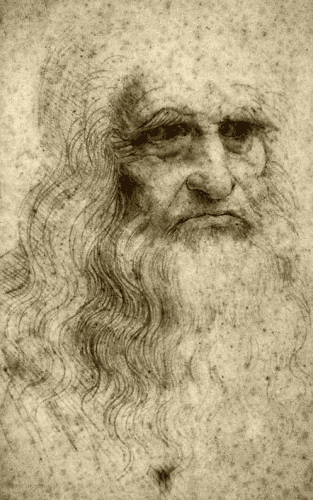
0 notes
Text
Explore the Wonders of the Metropolitan Museum of Art
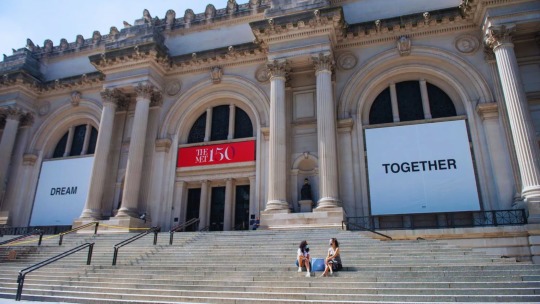
Explore the cultural tapestry woven at the Metropolitan Museum of Art, a sanctuary of artistic brilliance in the heart of New York City. Unearth the treasures of human history spanning 5,000 years, as we embark on a visual odyssey through this iconic institution.
Egyptian Splendors: A Glimpse into Ancient Mysteries
Delve into the enigmatic world of Egypt with the Metropolitan Museum's captivating Egyptian Art collection. Mummies, hieroglyphs, and artifacts from a bygone era await, with the Temple of Dendur standing as a testament to ancient craftsmanship and architectural grandeur.
European Elegance: A Canvas of Timeless Masterpieces
Immerse yourself in the richness of European art as you traverse the halls adorned with masterpieces by Rembrandt, Vermeer, and Van Gogh. From the Renaissance to the Impressionist era, witness the evolution of artistic expression in the European Paintings collection.
American Tapestry: Chronicles of a Nation's Artistic Journey
The American Wing invites you to witness the unfolding narrative of American art, from colonial times to the present day. Iconic works like Emanuel Leutze's "Washington Crossing the Delaware" and sculptures by Augustus Saint-Gaudens punctuate this chronicle of creativity.
Eastern Elegance: A Panorama of Asian Artistry
Embark on a journey through the East with the Asian Art department, showcasing a breathtaking array of artifacts from China, Japan, and Korea. From ancient ceramics to contemporary installations, the collection provides a comprehensive view of Asian artistic traditions.
Time Travel at The Met Cloisters: A Medieval Escape
Step into the ethereal realm of The Met Cloisters, nestled in Fort Tryon Park. This medieval European haven offers a unique experience surrounded by art and architecture from a bygone era. Gardens, chapels, and cloisters beckon, creating a serene atmosphere.
Beyond Art: A Symphony of Decorative Arts and More
The Met goes beyond conventional art forms, housing an impressive collection of decorative arts, textiles, and musical instruments. Explore the diversity within the museum's walls, where every corner reveals a new facet of human creativity.
Dynamic Presentations: Special Exhibitions and Educational Initiatives
The Met constantly evolves with special exhibitions that illuminate specific themes, artists, or periods. These exhibits provide a fresh lens through which to view rare and extraordinary pieces, ensuring a dynamic and ever-changing experience for visitors.
Education Hub: Nurturing Art Enthusiasts of All Ages
The Met's commitment to education is evident in its diverse programs and resources. From guided tours to online exhibits, the museum strives to make art accessible and engaging. Conservation efforts ensure the preservation of delicate artworks, fostering a cultural legacy.
Central Park Reverie: A Post-Art Stroll
Situated on the edge of Central Park, the Met offers not just a cultural feast but also a picturesque setting. After exploring the vast galleries, take a leisurely stroll through the park, reflecting on the beauty encountered within the museum's walls.
In conclusion, the Metropolitan Museum of Art is a cultural beacon that captivates and inspires. Its commitment to preserving, presenting, and educating about art makes it an enriching destination. Whether you're a seasoned art connoisseur or a casual observer, a visit to the Met promises an unforgettable journey through the wonders of human creativity.
1 note
·
View note
Text
Holidays 10.31
Holidays
American Indian Day (Tennessee)
Bitcoin Day
Day of Local Songs (Peru)
Day of the 7 Billion
Día de la Canción Criolla (Peru)
Girl Scout Founder’s Day
International Black Sea Action Day
John Candy Day (Toronto, Canada)
King Father’s Day (Cambodia)
Martyr’s Day (Burkina Faso)
Medusa Day
Mount Rushmore Day
National Bug Busting Day (UK)
National Evangelism Day
National Prince Day
National Unity Day (India)
Non-Working Day (Russia)
Phi Day
Plough Tree Day (French Republic)
Rabbit Rabbit Day [Last Day of Every Month]
Reformation Day (Slovenia)
Senior Absurdity Day (Bronx, NY)
Spider-Girl Day
World Cities Day (UN)
World Savings Day
World Thrift Day (India)
Youth Honor Day (Iowa)
Food & Drink Celebrations
Billy Beer Day (Plains, Georgia)
Brewtopia (NYC)
International Day of Rice
Japanese Tea Day (Japan)
National Caramel Apple Day
National Keg Day
The United Nations of Beer (New York)
5th & Last Tuesday in October
Mix It Up at Lunch Day [Last Tuesday]
Independence Days
Edan (Declared; 1999) [unrecognized]
Nevada Statehood Day (#36; 1864)
Wellington (Declared; 2009) [unrecognized]
Feast Days
Abaidas (Coptic Church)
Alphonsus Rodriguez (Christian; Saint)
Ampliatus (Christian; Saint)
Begu (Christian; Saint)
Bob Crane Day (Church of the SubGenius; Saint)
Erc of Slane (in Cornwall; Christian; Saint)
Feast of Sekhmet Bast Ra (Ancient Egypt)
Felix the Chicken (Muppetism)
Festival of Inner Worlds
Foillan (in Namur; Christian; Saint)
Gerbil Caressing Day (Pastafarian)
Hallowe’en (also celebrated as ...
Allantide (Cornwall, UK)
All Hallows Eve
Apple and Candle Night (Wales)
Beggar's Night
Beltaine [Southern Hemisphere; begins at sunset]
Books For Treats Day
Caramel Apple Day
Carve a Pumpkin Day
Chiang Kai-Shek Day (Taiwan)
Day of the Dead begins (Mexico) [until 11.2]
Dookie Apple Night (Newcastle, UK)
Duck Apple Night (Liverpool, UK)
Fright Night (Pastafarian)
Ghostwriter’s Day
Halloween
Hop-tu-Naa (Isle of Man)
Increase Your Psychic Powers Day
National Doorbell Day
National Dress Like a Slut Day
National Keg Day
National Knock-Knock Joke Day
National Magic Day
National UNICEF Day
Night of a Thousand Screams (Church of the SubGenius; Saint)
Nut-Crack Night (UK)
Out of the Broom Closet Day
Saci Day (Brazil)
Samhain [Northern Hemisphere; begins at sunset]
Samhain Eve (Celtic, Pagan) [7 of 8 Festivals of the Natural Year]
Scare a Friend Day
Sneak Some of the Candy Before the Kids Start Knocking Day
Thump-the-Door Night (Isle of Man)
Trick or Treat Night
Isis/Osiris Mysteries IV (Pagan)
Johannes Vermeer (Artology)
Kant (Positivist; Saint)
Makoshe’s Holiday (Asatru/Pagan Slavic celebration of Mother Earth)
Marie Laurencin (Artology)
Martin Luther (Anglican Communion)
Meindert Hobbema (Artology)
Old Celtic New Year’s Eve
Paul Shinji Sasaki and Philip Lindel Tsen (Episcopal Church)
Reformation Day (Germany, Slovenia, Lutheran Church)
Quentin (Christian; Saint)
Theodore Romzha, Blessed (Ruthenian Catholic Church)
Vetmaetr (Norse beginning of winter, start of Odin leading the Wild Hunt)
Wolfgang of Regensburg (Christian; Saint) [Germany]
Lucky & Unlucky Days
Sensho (先勝 Japan) [Good luck in the morning, bad luck in the afternoon.]
Uncyclopedia Bad to Be Born Today (because it’s Xt'Tapalatakettle's Day.)
Unfortunate Day (Pagan) [51 of 57]
Premieres
The Adventures of Sherlock Holmes, by Arthur Conan Doyle (Novel; 1892)
All Wet (Disney Cartoon; 1927)
Ash vs. Evil Dead (Film; 2015)
Bohemian Rhapsody, by Queen (Song; 1975)
Catty Cornered (WB MM Cartoon; 1953)
The Country Cousin (Disney Cartoon; 1936)
Explosive Situation or Don’t Make It Worse — It’s Badenov (Rocky & Bullwinkle Cartoon, S3, Ep. 121; 1961)
Foul Hunting (Disney Cartoon; 1947)
Girls! Girls! Girls! (Film; 1960) [Elvis Presley #11]
I Only Have Eyes For You, recorded by The Flamingos (Song; 1958)
Like a Virgin, by Madonna (Song; 1984)
Livin’ on a Prayer, by Bon Jovi (Song; 1986)
A Modest Proposal, by Jonathan Swift (Essay; 1726)
Ninety-Five Theses, by Martin Luther (Pamphlet; 1517)
Period of Adjustment (Film; 1962)
The Red Sea Sharks, by Hergé (Graphic Novel; 1958) [Tintin #19]
The Secret Teachings of All Ages, by Manly P. Hall (Book; 1928)
Somebody Stole My Gal, recorded by Count Basie (Song; 1930)
Spellbound (Film; 1945)
Star Dust, recorded by Hoagy Carmichael (Song; 1927)
Strategy, by B.H. Liddell Hart (Book; 1929)
Two Weeks Vacation (Disney Cartoon; 1952)
Unplugged MTV Show, recorded by Squeeze Live Show; 1989) [1st Unplugged Show]
The Walking Dead (TV Series; 2010)
What Ever Happened to Baby Jane (Film; 1962)
A Witch’s Tangled Hare (WB LT Cartoon; 1959)
You’ve Got Me in Switches or Suture Self (Rocky & Bullwinkle Cartoon, S3, Ep. 122; 1961)
Zack and Miri Make a Porno (Film; 2008)
Today’s Name Days
Christoph, Quentin, Wolfgang (Austria)
Alfons, Volfgang, Vukmir (Croatia)
Štěpánka (Czech Republic)
Louise (Denmark)
Ardo, Ardu, Arti, Arto, Artur (Estonia)
Arto, Arttu, Artturi (Finland)
Quentin (France)
Melanie, Quentin, Wolfgang (Germany)
Ablia, Apellis, Aristovoulos, Narkisos, Stratoniki (Greece)
Farkas (Hungary)
Lucilla (Italy)
Rinalds, Smilga, Valts, Volfgangs (Latvia)
Alfonsas, Liucilė, Tanvilė (Lithuania)
Edit, Edna (Norway)
Alfons, Alfonsyna, Antoni, Antonina, August, Augusta, Godzimir, Godzisz, Lucylla, Łukasz, Saturnin, Saturnina, Urban, Wolfgang (Poland)
Amplie, Afelie, Aristobul, Narcis, Stahie, Urban (Romania)
Aurélia (Slovakia)
Alonso, Quintín (Spain)
Edgar, Edit (Sweden)
Maura, Moira (Ukraine)
Cruz, Flint, Flynn, Kruz, Trent, Trenton (USA)
Today is Also…
Day of Year: Day 304 of 2024; 61 days remaining in the year
ISO: Day 2 of week 44 of 2023
Celtic Tree Calendar: Ngetal (Reed) [Day 1 of 28]
Chinese: Month 9 (Ten-Xu), Day 17 (Ren-Xu)
Chinese Year of the: Rabbit 4721 (until February 10, 2024)
Hebrew: 16 Heshvan 5784
Islamic: 16 Rabi II 1445
J Cal: 4 Mir; Foursday [4 of 30]
Julian: 18 October 2023
Moon: 91%: Waxing Gibbous
Positivist: 24 Descartes (11th Month) [Kant]
Runic Half Month: Hagal (Hailstone) [Day 5 of 15]
Season: Autumn (Day 38 of 89)
Zodiac: Scorpio (Day 8 of 29)
Calendar Changes
Ngetal (Reed) [Celtic Tree Calendar; Month 12 of 13]
0 notes
Text
Holidays 10.31
Holidays
American Indian Day (Tennessee)
Bitcoin Day
Day of Local Songs (Peru)
Day of the 7 Billion
Día de la Canción Criolla (Peru)
Girl Scout Founder’s Day
International Black Sea Action Day
John Candy Day (Toronto, Canada)
King Father’s Day (Cambodia)
Martyr’s Day (Burkina Faso)
Medusa Day
Mount Rushmore Day
National Bug Busting Day (UK)
National Evangelism Day
National Prince Day
National Unity Day (India)
Non-Working Day (Russia)
Phi Day
Plough Tree Day (French Republic)
Rabbit Rabbit Day [Last Day of Every Month]
Reformation Day (Slovenia)
Senior Absurdity Day (Bronx, NY)
Spider-Girl Day
World Cities Day (UN)
World Savings Day
World Thrift Day (India)
Youth Honor Day (Iowa)
Food & Drink Celebrations
Billy Beer Day (Plains, Georgia)
Brewtopia (NYC)
International Day of Rice
Japanese Tea Day (Japan)
National Caramel Apple Day
National Keg Day
The United Nations of Beer (New York)
5th & Last Tuesday in October
Mix It Up at Lunch Day [Last Tuesday]
Independence Days
Edan (Declared; 1999) [unrecognized]
Nevada Statehood Day (#36; 1864)
Wellington (Declared; 2009) [unrecognized]
Feast Days
Abaidas (Coptic Church)
Alphonsus Rodriguez (Christian; Saint)
Ampliatus (Christian; Saint)
Begu (Christian; Saint)
Bob Crane Day (Church of the SubGenius; Saint)
Erc of Slane (in Cornwall; Christian; Saint)
Feast of Sekhmet Bast Ra (Ancient Egypt)
Felix the Chicken (Muppetism)
Festival of Inner Worlds
Foillan (in Namur; Christian; Saint)
Gerbil Caressing Day (Pastafarian)
Hallowe’en (also celebrated as ...
Allantide (Cornwall, UK)
All Hallows Eve
Apple and Candle Night (Wales)
Beggar's Night
Beltaine [Southern Hemisphere; begins at sunset]
Books For Treats Day
Caramel Apple Day
Carve a Pumpkin Day
Chiang Kai-Shek Day (Taiwan)
Day of the Dead begins (Mexico) [until 11.2]
Dookie Apple Night (Newcastle, UK)
Duck Apple Night (Liverpool, UK)
Fright Night (Pastafarian)
Ghostwriter’s Day
Halloween
Hop-tu-Naa (Isle of Man)
Increase Your Psychic Powers Day
National Doorbell Day
National Dress Like a Slut Day
National Keg Day
National Knock-Knock Joke Day
National Magic Day
National UNICEF Day
Night of a Thousand Screams (Church of the SubGenius; Saint)
Nut-Crack Night (UK)
Out of the Broom Closet Day
Saci Day (Brazil)
Samhain [Northern Hemisphere; begins at sunset]
Samhain Eve (Celtic, Pagan) [7 of 8 Festivals of the Natural Year]
Scare a Friend Day
Sneak Some of the Candy Before the Kids Start Knocking Day
Thump-the-Door Night (Isle of Man)
Trick or Treat Night
Isis/Osiris Mysteries IV (Pagan)
Johannes Vermeer (Artology)
Kant (Positivist; Saint)
Makoshe’s Holiday (Asatru/Pagan Slavic celebration of Mother Earth)
Marie Laurencin (Artology)
Martin Luther (Anglican Communion)
Meindert Hobbema (Artology)
Old Celtic New Year’s Eve
Paul Shinji Sasaki and Philip Lindel Tsen (Episcopal Church)
Reformation Day (Germany, Slovenia, Lutheran Church)
Quentin (Christian; Saint)
Theodore Romzha, Blessed (Ruthenian Catholic Church)
Vetmaetr (Norse beginning of winter, start of Odin leading the Wild Hunt)
Wolfgang of Regensburg (Christian; Saint) [Germany]
Lucky & Unlucky Days
Sensho (先勝 Japan) [Good luck in the morning, bad luck in the afternoon.]
Uncyclopedia Bad to Be Born Today (because it’s Xt'Tapalatakettle's Day.)
Unfortunate Day (Pagan) [51 of 57]
Premieres
The Adventures of Sherlock Holmes, by Arthur Conan Doyle (Novel; 1892)
All Wet (Disney Cartoon; 1927)
Ash vs. Evil Dead (Film; 2015)
Bohemian Rhapsody, by Queen (Song; 1975)
Catty Cornered (WB MM Cartoon; 1953)
The Country Cousin (Disney Cartoon; 1936)
Explosive Situation or Don’t Make It Worse — It’s Badenov (Rocky & Bullwinkle Cartoon, S3, Ep. 121; 1961)
Foul Hunting (Disney Cartoon; 1947)
Girls! Girls! Girls! (Film; 1960) [Elvis Presley #11]
I Only Have Eyes For You, recorded by The Flamingos (Song; 1958)
Like a Virgin, by Madonna (Song; 1984)
Livin’ on a Prayer, by Bon Jovi (Song; 1986)
A Modest Proposal, by Jonathan Swift (Essay; 1726)
Ninety-Five Theses, by Martin Luther (Pamphlet; 1517)
Period of Adjustment (Film; 1962)
The Red Sea Sharks, by Hergé (Graphic Novel; 1958) [Tintin #19]
The Secret Teachings of All Ages, by Manly P. Hall (Book; 1928)
Somebody Stole My Gal, recorded by Count Basie (Song; 1930)
Spellbound (Film; 1945)
Star Dust, recorded by Hoagy Carmichael (Song; 1927)
Strategy, by B.H. Liddell Hart (Book; 1929)
Two Weeks Vacation (Disney Cartoon; 1952)
Unplugged MTV Show, recorded by Squeeze Live Show; 1989) [1st Unplugged Show]
The Walking Dead (TV Series; 2010)
What Ever Happened to Baby Jane (Film; 1962)
A Witch’s Tangled Hare (WB LT Cartoon; 1959)
You’ve Got Me in Switches or Suture Self (Rocky & Bullwinkle Cartoon, S3, Ep. 122; 1961)
Zack and Miri Make a Porno (Film; 2008)
Today’s Name Days
Christoph, Quentin, Wolfgang (Austria)
Alfons, Volfgang, Vukmir (Croatia)
Štěpánka (Czech Republic)
Louise (Denmark)
Ardo, Ardu, Arti, Arto, Artur (Estonia)
Arto, Arttu, Artturi (Finland)
Quentin (France)
Melanie, Quentin, Wolfgang (Germany)
Ablia, Apellis, Aristovoulos, Narkisos, Stratoniki (Greece)
Farkas (Hungary)
Lucilla (Italy)
Rinalds, Smilga, Valts, Volfgangs (Latvia)
Alfonsas, Liucilė, Tanvilė (Lithuania)
Edit, Edna (Norway)
Alfons, Alfonsyna, Antoni, Antonina, August, Augusta, Godzimir, Godzisz, Lucylla, Łukasz, Saturnin, Saturnina, Urban, Wolfgang (Poland)
Amplie, Afelie, Aristobul, Narcis, Stahie, Urban (Romania)
Aurélia (Slovakia)
Alonso, Quintín (Spain)
Edgar, Edit (Sweden)
Maura, Moira (Ukraine)
Cruz, Flint, Flynn, Kruz, Trent, Trenton (USA)
Today is Also…
Day of Year: Day 304 of 2024; 61 days remaining in the year
ISO: Day 2 of week 44 of 2023
Celtic Tree Calendar: Ngetal (Reed) [Day 1 of 28]
Chinese: Month 9 (Ten-Xu), Day 17 (Ren-Xu)
Chinese Year of the: Rabbit 4721 (until February 10, 2024)
Hebrew: 16 Heshvan 5784
Islamic: 16 Rabi II 1445
J Cal: 4 Mir; Foursday [4 of 30]
Julian: 18 October 2023
Moon: 91%: Waxing Gibbous
Positivist: 24 Descartes (11th Month) [Kant]
Runic Half Month: Hagal (Hailstone) [Day 5 of 15]
Season: Autumn (Day 38 of 89)
Zodiac: Scorpio (Day 8 of 29)
Calendar Changes
Ngetal (Reed) [Celtic Tree Calendar; Month 12 of 13]
0 notes
Text
Vermeer : A Postscript
In the text of my Study in this series that is about Vermeer I include a reproduction of a now lost picture of a servant clutching a letter as she looks down towards a child holding a bowl. If that work was a Vermeer, I wondered why there are no surviving ones that contain young children. The house he shared with his wife, Catharina, was full of them at different times. I speculated that perhaps it was because they were so lively and never still; the girls would become suitable models when they were young women.
I now wish to put forward a further possible Vermeer. It is a sad image of a young girl who is certainly still because she is on her death bed.
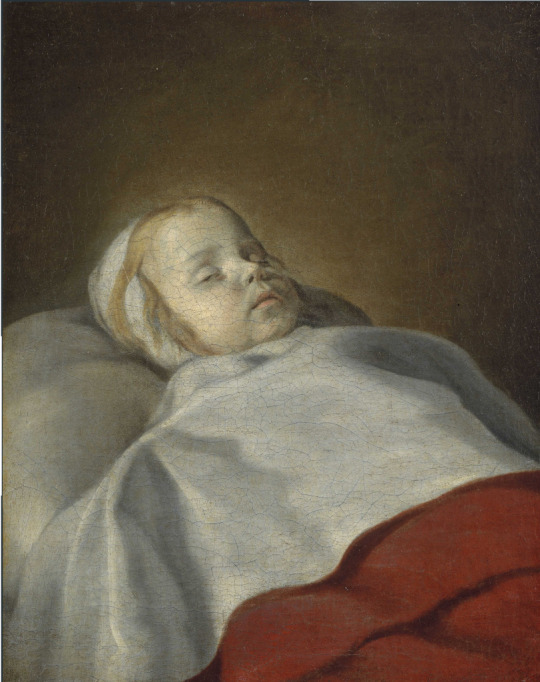
This poignant, tender and very beautiful picture is at the Musee des Beaux Arts at Besançon in France, where it hangs unattributed as a Portrait of a Dead Child, Flemish from the 17th century. Obviously it is a very personal painting, the work of a grieving parent. The artist brings us to the very edge of the bed where his child lies. Her eyes are nearly closed, the shape of them like the eyes of the boy in a drawing, below, at Berlin. Her hair is a pale flaxen colour, a lighter version of the yellow so often used by Vermeer, in the Lacemaker, for example, or the Girl with a Pearl Earring. There is a slight halo around her head. The folds of pillow and coverlet have a ghostly pallor, soft and unfocussed, like a mantle of snow. Most remarkable of all is the absence of ordinary daylight, the same absence one finds in Vermeer’s Servant asleep at a Table (at the New York Metropolitan Museum), except that the servant is merely asleep, but the child is gone into the darkness above her bloodless face, ashen now like the bedsheet. Under that sheet is a deep red blanket forming a triangle in the lower right corner of the picture.
It is the particular red of this blanket that alerts me to the possibility that the picture is a Vermeer. There are pictures by him that have no red in them at all, but this red, in deeper and lighter shades, is nevertheless a feature of his palette that recurs quite often. It is the red, for example, that we find in the jacket of the girl reading a score in The Girl Interrupted at Her Music at the Frick Collection in New York, and again in the Girl Drinking with a Gentleman, at Berlin. It is the colour of the roof tiles in The View of Delft, at the Mauritshuis, and of the skirt of the woman with her back to us, who stands at the virginals in the Royal Collection’s Music Lesson. Somewhat lighter, it is the red of the woman’s satin dress in the Couple with a Wine Glass, at Brunswick, and in two early works, the Edinburgh Christ in the House of Mary and Martha (where Mary wears it) and in the Dresden Procuress, in the jerkin of the man who fondles her breast. At Besançon the colour is deep and it speaks to us differently: in the presence of death it is an assertion, and reminder, of life, and life blood.
The comparisons made below, between the Besançon Dead Child, focus on two aspects of the former, the red of the blanket and the brownish background. Clearly the colours in reproductions vary in their fidelity to those in the originals; so, if there is merit in my attribution to Vermeer, it behoves those more acquainted with the originals, such as the curators of the current Vermeer exhibition at the Rijksmuseum in Amsterdam, to make their judgement accordingly. The hue of a red, or any colour, may be deeper or lighter. My argument relies on the red in question being essentially the same as what we find in his pictures, only in differing strengths. The colour of walls in Vermeer shows wonderful variations according to the degree of light falling on them. At Besançon there is, appropriately, a very subdued, ‘dead’ light, not the lively one that enters through a window.

Clockwise from Top Left: View of Delft (Mauritshuis); Portrait of a Dead Child (Musee des Beaux Arts, Besançon); The Wine Glass (Gemäldergallerie Berlin); At the Procuress (Staatlichekunstsammlungen Dresden); Girl Interrupted at her Music; Officer and the Laughing Girl (Frick Collection)

Clockwise from top left: The Geographer (Städel Museum Frankfurt); Portrait of a Dead Child; Girl Reading a Letter (Gemäldegalerie Alte Meister Dresden); Young Woman Seated at a Virginal (National Gallery London); At the Procuress; Centre: Study of a Boy’s Head (Berlin Printroom)
As for the identity of the child, if this is indeed a Vermeer she must be one of the four daughters born before a son arrived in 1654; the approximate date of the picture, ‘circa 1650’, suggested by the Besançon Museum is therefore a reasonable guess.
The craquelure, it may be added, is also compatible with an attribution to Vermeer. The painting is on canvas and rather larger than one might expect (58 x 47.5 cm) for so intimate a scene.
I should add, by way of a concession to sceptics, that the argument here is not an easy one to make, because the very restricted content of the picture offers little with which to build it; around the head of the child only bedclothes and a blank wall. A blank wall by Vermeer is nevertheless different from a blank wall by Nicholas Maes or Pieter de Hooch.The case for attribution to Vermeer rests on features described above, and I hope they are enough when taken with what seems to be the case, that no other attribution has been suggested within mid-seventeenth century Netherlands that meets the obvious quality of this work.
The description just made, of the background in the picture as a ‘blank wall’ is not really correct; it is not a background, nor is it a wall, but rather an overtaking nothingness, the visual representation of absence and loss. Because Vermeer and his wife were fecund and had many children does not mean that the loss of any one of them was not a very sad occasion which he, as a painter, might well have wished to mark. If this painting is by him, as I am inclined to think, then it is further evidence that family was at the centre of his art, as of his life. He painted and celebrated the visible, the world of living light and shadow; sleep and death remove us from it, but what the sleeping servant and the dead child cannot see is still there to be seen and to be witnessed, albeit in a manner appropriate to those states, in a ‘dying of the light’.
#vermeer#lost paintings#dutch painter#painting#art history#studies in connoisseurship#connoisseurship
1 note
·
View note